Bogotá, Colombia 作者: 来源: 发布时间:2021-03-22
1. Population and Area
Bogotá, formerly known as Santa Fe de Bogotá between 1991 and 2000, is the capital and largest city of Colombia, administered as the Capital District, as well as the capital of the department of Cundinamarca. Bogotá is a territorial entity of the first order, with the same administrative status as the departments of Colombia. It is the political, economic, administrative and industrial center of the country.
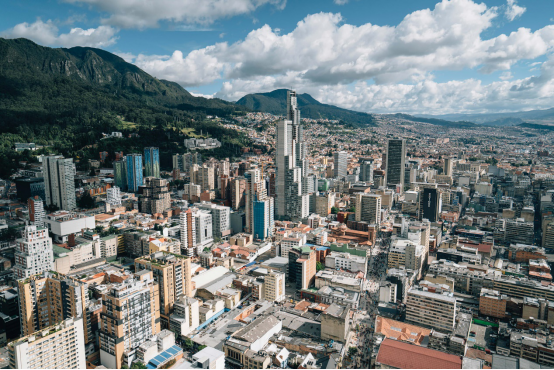
Population: 7,412,566 (2018)
Area: 1,587 km2 (613 sq mi)
Location:
The city is located in the center of Colombia, on a high plateau known as the Bogotá savanna, part of the Altiplano Cundiboyacense located in the Eastern Cordillera of the Andes.
2. Geography
Bogotá is located in the southeastern part of the Bogotá savanna (Sabana de Bogotá) at an average altitude of 2,640 metres (8,660 ft) above sea level. The Bogotá savanna is popularly called "savannah" (sabana), but constitutes actually a high plateau in the Andes mountains, part of an extended region known as the Altiplano Cundiboyacense, which literally means "high plateau of Cundinamarca and Boyacá". Bogotá is the largest city in the world at its elevation; there is no urban area that is both higher and more populous than Bogotá.
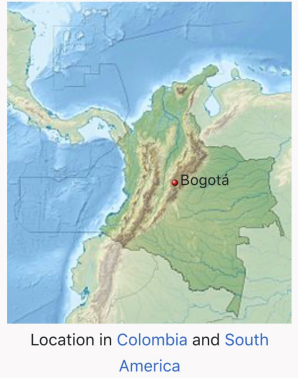
In the extreme south of Bogota's District, the world's largest continuous paramo ecosystem can be found; Sumapaz Páramo in the locality Sumapaz.
The Bogotá River running NE-SW crosses the sabana, forming Tequendama Falls (Salto del Tequendama) to the south. Tributary rivers form valleys with flourishing villages, whose economy is based on agriculture, livestock raising and artisanal production.
The sabana is bordered to the east by the Eastern Cordillera of the Andes mountain range. The Eastern Hills, which limit city growth, run from south to north, and form east of the center the Guadalupe and Monserrate mountains. The western city limit is the Bogotá River. The Sumapaz Paramo (moorland) borders the south and to the north Bogotá extends over the plateau up to the towns of Chía and Sopó.
Eastern Hills
Most of the wetlands in the Bogota region have disappeared. They covered nearly 50,000 hectares in the 1960s, compared to only 727 in 2019, for a disappearance rate of 98%.
Transportation
Bogotá's growth has placed a strain on its roads and highways, but since 1998 significant efforts to upgrade the infrastructure have been undertaken. Private car ownership forms a major part of the congestion, in addition to taxis, buses and commercial vehicles. Buses remain the main means of mass transit. There are two bus systems: the traditional system and the TransMilenio.
The traditional system runs a variety of bus types, operated by several companies on normal streets and avenues: Bus (large buses), Buseta (medium size buses) and Colectivo (vans or minivans). The bigger buses were divided into two categories: Ejecutivo, which was originally to be a deluxe service and was not to carry standing passengers, and corriente or normal service. Since May 2008, all buses run as corriente services. Bogotá is a hub for domestic and international bus routes. The Bogotá terminal serves routes to most cities and towns in Colombia and is the largest in the country. There is international service to Ecuador, Perú and Venezuela.
The TransMilenio system was created during Enrique Peñalosa's mayoral term, and is a form of bus rapid transit that has been deployed as a measure to compensate for the lack of a subway or rail system. TransMilenio combines articulated buses that operate on dedicated bus roads (busways) and smaller buses (feeders) that operate in residential areas, bringing passengers to the main grid. TransMilenio's main routes are: Caracas Avenue, Northern Highway (Autopista Norte), 80th Street, Americas Avenue, Jiménez Avenue, and 30th Avenue (also referred to as Norte Quito Sur or N.Q.S. for short). Routes for Suba Avenue and Southern Highway (Autopista Sur), the southern leg of the 30th Avenue, were opened in April 2006. The third phase of the system will cover 7th Avenue, 10th Avenue, and 26th Street (or Avenida El Dorado). The system is planned to cover the entire city by 2030. Although the Transmilenio carries commuters to numerous corners of the city, it is more expensive (US$0.80 or 2300 COP) than any public transport, except taxis.
In addition to TransMilenio, the Peñalosa administration and voter-approved referenda helped to establish travel restrictions on cars with certain license plate numbers during peak hours called Pico y placa; 121 kilometres (75 miles) of Ciclovía on Sundays and major holidays; a massive system (376 km (234 mi) as of 2013) of bicycle paths and segregated lanes called ciclorrutas; and the removal of thousands of parking spots in an attempt to make roads more pedestrian-friendly and discourage car use. Ciclorrutas is one of the most extensive dedicated bike path networks of any city in the world, with a total extension of 376 kilometres (234 miles). It extends from the north of the city, 170th Street, to the south, 27th Street, and from Monserrate on the east to the Bogotá River on the west. The ciclorruta was started by the 1995–1998 Antanas Mockus administration with a few kilometers, and considerably extended afterwards with the development of a Bicycle Master Plan and the addition of paths hundreds of kilometers in extent. Since the construction of the ciclorruta bicycle use in the city has increased, and a car free week was introduced in 2014.
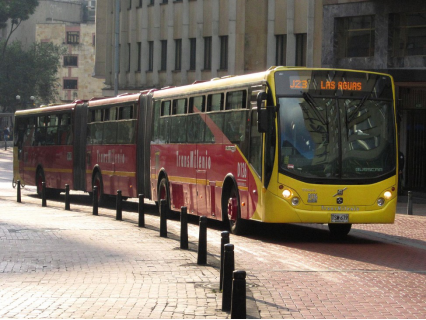
Bi-articulated TransMilenio bus
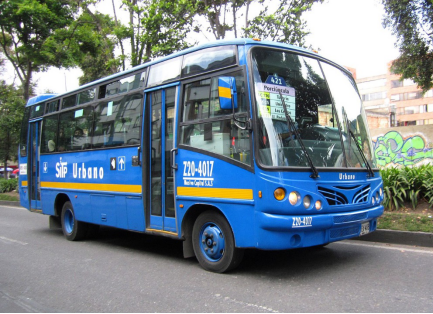
Urban (SITP) bus, part of the integrated public transport system
3. Economy
Bogotá has the highest nominal GDP in the country, responsible for almost a quarter of the nation's total (24.7%). It hosts the main financial market in Colombia and the Andean natural region, and is the leading destination for new foreign direct investment projects coming into Latin America and Colombia.
Bogotá is the main economic and industrial center of Colombia. In 2016 the World Cities Study Group and Network (GaWC) from the United Kingdom ranked Bogotá as an Alpha−World City in the World Cities Study Group's inventory, a high-ranking. Alpha and Alpha- cities are important world cities that link major economic regions into the world economy.
4. Industry
Tourism
Travel & Tourism's share of the city's overall GDP stands at 2.5%. Bogotá is responsible for 56% of the tourism that arrives to Colombia and is home of 1,423 multinational companies. Bogotá also ranked highly as a global city where business is done and meetings are held. Bogotá is a growing international meetings destination.
Shopping malls
Bogotá's economy has been significantly boosted due to new shopping malls built within the last few years. As of December 2011, over 160 new malls are planned in addition to the existing 100 malls. Notable malls include: Centro Andino, Centro Mayor, Santafé, Gran Estación.
Bogota is also the largest market and production center for the food and beverage industry in the country.
5. Tourist attractions
La Candelaria
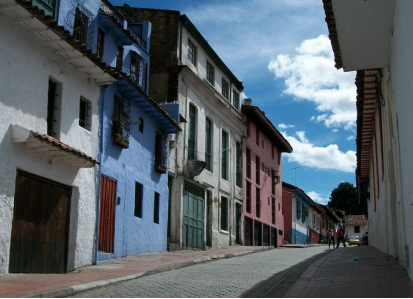
La Candelaria is the 17th locality of Bogotá, Colombia. A historic neighborhood in the city's downtown, it is the equivalent to the Old City in other cities. The architecture of the old houses, churches and buildings has Spanish Colonial, Baroque and art deco styles. It houses several universities, libraries and museums.
Bogotá Botanical Garden
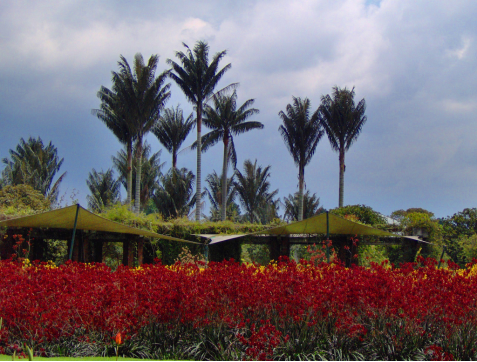
The José Celestino Mutis botanical garden is Colombia's biggest botanical garden. It serves both as a recreation and research center with an emphasis on Andean and Páramo ecosystems. The garden is located in Bogotá and features plants from every Colombian altitude, climate and region. It was founded in 1955, in honor of botanist and astronomer José Celestino Mutis.
The garden has an artificial waterfall and labs for studying plants and flowers. It also has public services such as a library and a tourist information desk. The garden is the only one in the nation specialized in preserving and collecting Andean species of flowers. Its 19.5 acres are full with collections of plants grouped by their original ecosystem.
Quinta de Bolívar
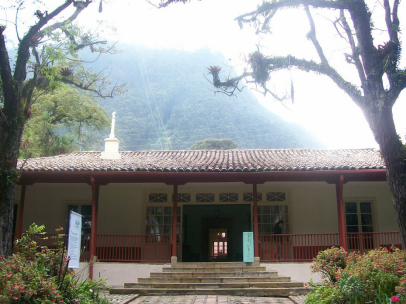
The Quinta de Bolivar is a colonial house in Bogota, Colombia, that served as a residence to Simon Bolivar in the capital after the war of independence. It is now used as a museum dedicated to Bolivar's life and times.
6. History and culture
History
Long before the Spanish Conquest, the Sabana de Bogotá, a fertile highland basin that today has been almost entirely taken over by the city, was inhabited by one of the most advanced pre-Columbian indigenous groups, the Muisca. The Spanish era began when Gonzalo Jiménez de Quesada and his expedition arrived at the Sabana, founding the town on August 6, 1538, near the Muisca capital, Bacatá.
The town was named Santa Fe de Bogotá, a combination of the traditional name, Bacatá, and Quesada's hometown in Spain, Santa Fe. Nonetheless, throughout the colonial period the town was simply referred to as Santa Fe.
At the time of its foundation Santa Fe consisted of 12 huts and a chapel, where a Mass was held to celebrate the town's birth. The Muisca religious sites were destroyed and replaced by churches.
During the early years Santa Fe was governed from Santo Domingo (on the island of Hispaniola, the present-day Dominican Republic), but in 1550 it fell under the rule of Lima, the capital of the Viceroyalty of Peru and the seat of Spain's power for the conquered territories of South America. In 1717 Santa Fe was made the capital of the Virreinato de la Nueva Granada, the newly created viceroyalty comprising the territories of present-day Colombia, Panama, Venezuela and Ecuador.
Despite the town's political importance, its development was hindered by the area's earthquakes, and also by the smallpox and typhoid epidemics that plagued the region throughout the 17th and 18th centuries.
After independence, the Congress of Cúcuta shortened the town's name to Bogotá in 1821 and decreed it the capital of Gran Colombia. The town developed steadily and by the middle of the 19th century it had 30,000 inhabitants and 30 churches. In 1884 the first tramway began to operate in the city and, soon after, railway lines were constructed to La Dorada and Girardot, giving Bogotá access to the ports on the Río Magdalena.
Rapid progress came only in the 1940s with industrialization and the consequent peasant migrations from the countryside. On April 9, 1948, the popular leader Jorge Eliécer Gaitán was assassinated, sparking the uprising known as El Bogotazo. The city was partly destroyed; 136 buildings were burnt to the ground and 2500 people died.
Tranquil life in Bogotá was rocked again on November 6, 1985, when guerrillas of the M-19 (Movimiento 19 de Abril) revolutionary movement invaded the Palace of Justice in Bogotá and made hostages of the 300-plus civilians in the building. By the next day, 115 people were dead, including 11 Supreme Court judges.
Colombia's historic 2016 peace deal with Revolutionary Armed Forces of Colombia (FARC), which ended a 52-year civil war, has Bogotá breathing a long-awaited sigh of relief. Dramatically improved safety, along with a host of progressive projects under successive mayors (eg the 350km of CicloRuta bike lanes), have helped the city make major strides toward positioning itself as not only a cultural capital but a destination in its own right.
Culture
Bogotá has many cultural venues including 58 museums, 62 art galleries, 33 library networks, 45 stage theaters, 75 sports and attraction parks, and over 150 national monuments. Many of these are renowned globally such as: The Luis Ángel Arango Library, the most important in the region which receives well over 6 million visitors a year; The Colombian National Museum, one of the oldest in the Americas, dating back to 1823; The Ibero-American Theater Festival, largest of its kind in the world, receives 2 million attendees enjoying over 450 performances across theaters and off the street; The Bogotá Philharmonic is the most important symphony orchestra in Colombia, with over 100 musicians and 140 performances a year. The city has been a member of the UNESCO Creative Cities Network in the category of music since March 2012.
The Cristóbal Colón Theater, the country's oldest Opera House, opened in 1892. It is home to the National Symphony Association's major act, the National Symphony Orchestra of Colombia.
Rock al Parque or Rock at the Park is an open air rock music festival. Recurring annually, it gathers over 320,000 music fans who can enjoy over 60 band performances for free during three days a year. The series have been so successful during its 15 years of operation that the city has replicated the initiative for other music genres, resulting in other recent festivals like Salsa at the Park, Hip Hop at the Park, Ballet at the Park, Opera at the Park, and Jazz at the Park.
Kids' Choice Awards Colombia, are the most important awards given in the city by Nickelodeon and the first ceremony was given in 2014 by the singer Maluma and in Corferias the ceremony has been the home of shows given by artists like Austin Mahone, Carlos Peña, Don Tetto and Riva among others.
Bogotá has worked in recent years to position itself as leader in cultural offerings in South America, and it is increasingly being recognized worldwide as a hub in the region for the development of the arts. In 2007, Bogotá was awarded the title of Cultural Capital of Ibero-America by the UCCI (Union of Ibero-American Capital Cities), and it became the only city to have received the recognition twice, after being awarded for the first time in 1991.
7. Other information
Bogotá ranks 52nd on the Global Cities Index 2014, and is considered a global city type "Alpha −" by GaWC.
8. Contact Information
Mayor: Claudia López
Website: https://bogota.gov.co/
Facebook: @AlcaldiaBogota
Tel: +5713813000
Office address: Cra. 8 #10-65, Bogotá, Colombia
